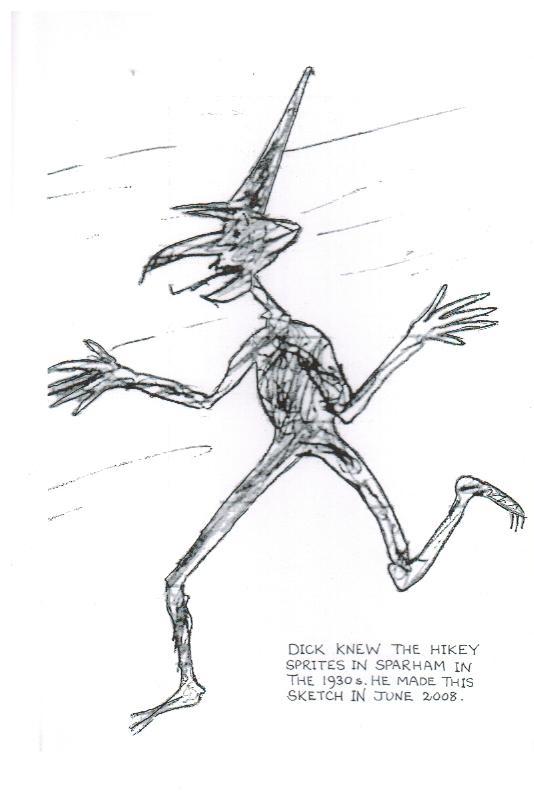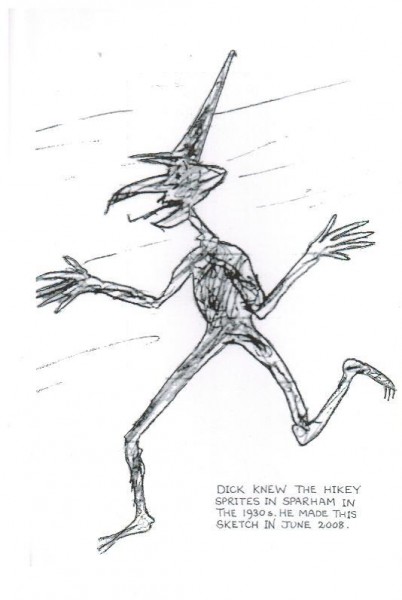(Image from Ray Loveday, Hikey Sprites)
The hikey is a fairy or bogey from Norfolk that terrified children in years gone by: ‘get home quickly or the hikeys will get you!’ However, the hikey was a little schizophrenic and sometimes helped human neighbours and did good deeds: rescuing children and lost donkeys. Other traditions include the idea that hikeys would raid houses where families had the temerity to leave Christmas decorations up after twelfth night (!) and that they sometimes stole objects. The other truly remarkable thing about the hikeys is how little has been written about them. There are two important and very well written modern studies, which compliment each other perfectly: Rabuzzi ‘Norfolk’s Hyter Sprites’ and Ray Loveday’s delightful Hikey Sprites (2009), a short booklet. But save an almost certainly misguided story by Ruth Tongue the Hikey was barely written about before this. In the nineteenth-century there were some very fleeting references, the earliest of which dates to 1872. If it was not for these scattered late nineteenth-century references it would be tempting to dismiss the hikey as a joke that got out of hand before the Second World War. Luckily we have just enough to be sure that this was not, in fact, the case.
Home Region: Ray Loveday the only present expert on Hikeys has shown in his studies that the H sprites seem to favour north eastern and central Norfolk and perhaps particularly the Broads. There have been claims that they were to be found in Lincolnshire and even Essex but this is simply not bourne out by the evidence.
Physical Description: Traditional knowledge about the Hikeys has declined to such an extent that even their appearance is unknown (if it ever was). However, the sketch above published by Ray Loveday (and drawn by an interviewee) will probably become the image that jumps into the mind of future hikey researchers. Ruth Tongue misled the fairy community (including Katherine Briggs) by talking of sandy-coloured invidividuals with green eyes who could turn into birds. There is no evidence for this: move on!
Earliest Attestation and Etymology: There is, frustratingly, no reference in the Oxford English Dictionary: we’ve complained so you don’t have to. Rabuzzi and Ray Loveday meanwhile gathered a number of different forms including: high sprite, highty sprightly, hike spike, hike sprike, hike sprite, hiker sprite, hikey, hikey pike, hikey sprite man, hoighty toight, hydra sprite, hyper sprite, hyte sprite, hyty sprite, ight sprite, ighty sprite, ikey sprite and sprikey. Hyter seems to be the original form but none of the etymologies suggested by scholars are even vaguely sensible, so we’ll spare you…
Hikey Locations: Ray Loveday notes that hikey sprites enjoy heathland, wet lands and land with beeches. There are some nineteenth-century references to hikeys at Blow Hill lane in Great Melton that conforms nicely with this.
Hikey Sighting: You be careful…
Hikey Story: Ruth Tongue’s Hikey Sprite (though this is widely thought to be suspect!)
Popular Culture: The hikey sprite seems to be, unfortunately, on its last legs with each generation leaving a weaker and weaker trace of hikey knowledge behind: Ray Loveday’s work is subtitled ‘the Twilight of a Norfolk Tradition’, which frankly says it all. The moon is already high in the sky, the sun has almost vanished. However, there is some cause for celebration. In 2013, Robert Coyle published a children’s book entitled the Hikey Sprite (Pen Press). Fingers crossed then for the Hikey and for Robert… It may be the little devils last chance.


